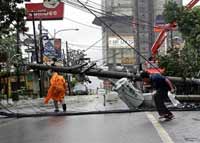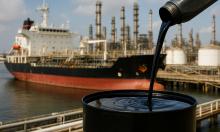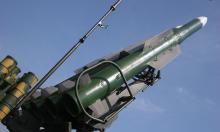Hundreds left missing after typhoon reaps through Philippines
Rescuers considered boring a hole in an overturned ferry Monday in a desperate attempt to find survivors among more than 800 missing passengers and crew, after Typhoon Fengshen carved its deadly swath through the Philippines.

Hopes dwindled by the hour that large groups of survivors might be found in areas where communications were cut off by the weekend storm that left 163 people dead in flooded communities. Divers rapped on the hull of the 23,824-ton Princess of Stars but heard no response from inside.
Only 38 wave-battered survivors have been found so far, including 28 who drifted at sea for more than 24 hours in life jackets before they were found Sunday about 80 miles (130 kilometers) to the north in Mulanay township, in eastern Quezon province.
But bodies were washing up on shore to the west and northwest, too. The coast guard said it was checking a survivor's report that at least one group of people, dead and alive, had been spotted bobbing in the sea.
A number of coast guard and navy ships swarmed to the area but were largely kept at bay by big waves in the still-roiling waters. A U.S. Navy ship was being dispatched from Okinawa.
Officials initially reported 747 passengers and crew were aboard the ferry, but said Monday that it was carrying about 100 more.
While some relatives tearfully waited for news, others were angry that the ship was allowed to leave Manila late Friday for a 20-hour trip to Cebu with a typhoon approaching. Debate began anew on safe-sailing rules in a country prone to storms - Fengshen was the seventh typhoon this year - and dependent on ferries to get around the sprawling archipelago.
The ship ran aground around noon Saturday a few miles (kilometers) off central Sibuyan island, then capsized.
Survivor Reynato Lanoria, a janitor on the ship, estimated about 100 people could have escaped the vessel, but thought the others were trapped inside. Lanoria said he was on the top deck when a crew member ordered people to put on life vests around 11:30 a.m. Saturday. About 30 minutes later, the ship began tilting so fast that elderly people and children fell on the slippery deck.
After the storm stymied earlier attempts to reach the ship and kept aircraft at bay, a rescue vessel battled huge waves and strong winds to approach Sunday, more than 24 hours after the ferry lost radio contact.
"They're scouring the area. They're studying the direction of the waves to determine where survivors may have drifted," coast guard spokesman Lt. Cmdr. Armand Balilo said.
The typhoon lashed the central Philippines early Saturday, setting off landslides and floods, knocking out power and blowing off roofs.
In the province of Iloilo, Gov. Neil Tupaz said 59 people drowned, with another 40 missing. "Almost all the towns are covered by water. It's like an ocean," Tupaz said.
Overall, hundreds were listed as missing.
Packing sustained winds of 74 miles (120 kilometers) per hour and gusts of up to 93 mph (150 kph), the typhoon shifted course Sunday to the northwest and battered Manila at dawn, dumping heavy rain on the capital.
Anthony Golez, deputy chief of the Office of Civil Defense, said the storm took an erratic path and never slowed down when it hit land with huge deluges of rain. It continued to dump rain on Luzon island and generate strong Monday as it headed in the general direction of China and Taiwan.
The Philippines was the scene of the world's worst peacetime maritime disaster when the ferry Dona Paz sank in 1987, killing more than 4,341 people.
Subscribe to Pravda.Ru Telegram channel, Facebook, RSS!





